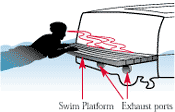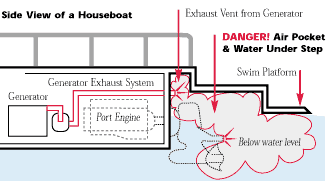 Boaters,
Protect yourselves from this Silent Killer:
Carbon Monoxide
Boaters,
Protect yourselves from this Silent Killer:
Carbon Monoxide
Carbon monoxide can collect within,
along side or behind a boat in minutes and in a
variety of ways.

Blockage of exhaust outlets
can cause carbon monoxide to
accumulate in the cabin and cockpit
area -even when hatches, windows,
portholes, and doors are closed.

Exhaust from another vessel
that is docked, beached, or anchored
alongside your boat can emit
poisonous carbon monoxide gas into
the cabin and cockpit of your boat.
Even with properly vented exhaust,
your boat should be a minimum of 20
feet from the nearest boat that is
running a generator or engine.

Slow speeds or idling in
the water can cause carbon monoxide
gas to accumulate in the cabin,
cockpit, bridge, and aft deck,
even in an open area.
A tailwind (force of wind entering
from aft section of the motorboat)
can also increase accumulation.

The "station wagon effect," or
backdrafting can cause
carbon monoxide to accumulate inside
the cabin, cockpit and bridge when
operating the boat at a high bow
angle, with improper or heavy
loading or if there is an opening
which draws in exhaust.
This effect can also cause carbon
monoxide to accumulate inside the
cabin, cockpit, aft deck, and bridge
when protective coverings are used
and the boat is underway.

Teak surfing, dragging and water
skiing within 20 feet of a moving
watercraft can be fatal.
Avoid these Death Zones!
Swimming near or under the back deck
or swim platform. Carbon monoxide from
exhaust pipes of inboard engines, outboard
engines and generators build up inside and
outside the boat in areas near exhaust vents.
STAY AWAY from these exhaust
vent areas and DO NOT swim in
these areas when the motor or generator is
operating. On calm days, wait at least 15
minutes after the motor or generator has been
shut off before entering these areas.
NEVER enter an enclosed area under a
swim platform where exhaust is vented, not even
for a second. It only takes one or two breaths
of the air in this "death chamber" for it to be
fatal.

What to do
- The best precaution against
carbon monoxide poisoning is to keep air
flowing through the vessel
- Educate family and friends about carbon
monoxide so they are aware of what the early
poisoning signs are
- If your boat has rear-vented generator
exhaust, check with the boat manufacturer
for possible recall or reroute the exhaust
to a safe area.
- Assign an adult to watch when anyone is
swimming or playing in the water.
- Schedule regular engine and exhaust
system maintenance inspections by
experienced and trained technicians.
- Keep forward-facing hatches open, even
in inclement weather, to allow fresh air
circulation in living spaces. When possible,
run the boat so that prevailing winds will
help dissipate the exhaust.
- Do not confuse carbon monoxide poisoning
with seasickness, intoxication or heat
stress. If someone on board complains of
irritated eyes, headache, nausea, weakness
or dizziness, immediately move the person to
fresh air, investigate the cause and take
corrective action. Seek medical attention,
if necessary.
- Install a carbon monoxide detector in
each accommodation space on your boat. Check
detectors before each trip to be sure they
are functioning properly. If the detector
goes off, believe it!
Facts
Carbon monoxide is a potentially deadly gas
produced any time a carbon-based fuel, such as
gasoline, propane, charcoal or oil, burns.
Sources on your boat include gasoline engines,
generators, cooking ranges, and space and water
heaters. Cold or poorly tuned engines produce
more carbon monoxide than warm, properly tuned
engines.
Carbon monoxide is colorless, odorless and
tasteless and mixes evenly with the air. It
enters your bloodstream through the lungs and
displaces the oxygen your body needs. Early
symptoms of carbon monoxide poisoning -
irritated eyes, headache, nausea, weakness, and
dizziness - are often confused with seasickness
or intoxication. Prolonged exposure to low
concentrations or very short exposure to high
concentrations can lead to death.
Each year, boaters are injured or killed by
carbon monoxide. Most incidents occur on older
boats and within the cabin or other enclosed
areas. Exhaust leaks, the leading cause of death
by carbon monoxide, can allow carbon monoxide to
migrate throughout the boat and into enclosed
areas. New areas of concern are the rear deck
near the swim platform with the generator or
engines running and teak surfing or dragging
behind a slow moving boat. Regular maintenance
and proper
boat operation can reduce the risk of injury
from carbon monoxide.
All carbon monoxide poisonings are
preventable!
| Checklist - Each
Trip |
- Educate all passengers
about carbon monoxide
poisoning.
- Make sure all exhaust
clamps are in place and
secure.
- Look for exhaust leaking
from exhaust system
components, indicated by
rust and/or black streaking,
water leaks, or corroded or
cracked fittings.
- Inspect rubber exhaust
hoses for burned or cracked
sections. All rubber hoses
should be pliable and free
of kinks.
- Confirm that water flows
from the exhaust outlet when
the engines and generator
are started.
- Listen for any change in
exhaust sound that could
indicate an exhaust
component failure.
- Test the operation of
each carbon monoxide
detector by pressing the
test button. Make sure the
battery is installed
properly and is in good
condition. Never remove the
battery unless replacing it
with a new battery
|
| Checklist - At Least
Annually |
- Replace exhaust hoses if
any evidence of cracking,
charring or deterioration is
found.
- Inspect each water pump
impeller and the water pump
housing, and replace if
worn. Make sure cooling
systems are in proper
working condition to prevent
overheating and burn through
the exhaust system. (Refer
to the engine and generator
manuals for further
information.)
- Inspect each of the
metallic exhaust components
for cracking, rusting,
leaking or loosening. Pay
particular attention to the
cylinder head, exhaust
manifold, water injection
elbow, and the threaded
adapter nipple between the
manifold and the elbow.
- Clean, inspect, and
confirm proper operation of
the generator cooling water
anti-siphon valve (if
equipped).
|
Annual Checklist must be
performed by a qualified marine
technician.
